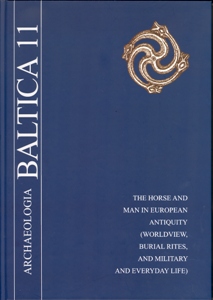Volume 11 (2009): The Horse and Man in European Antiquity (Worldview, Burial Rites, and Military and Everyday Life), August 2009

Order by:
Pub. online: 30 Aug 2009
Type: Article
 Open Access
Open Access
Journal:
Archaeologia Baltica
Volume 11 (2009): The Horse and Man in European Antiquity (Worldview, Burial Rites, and Military and Everyday Life), pp. 149–163
Abstract
Pub. online: 30 Aug 2009
Type: Article
 Open Access
Open Access
Journal:
Archaeologia Baltica
Volume 11 (2009): The Horse and Man in European Antiquity (Worldview, Burial Rites, and Military and Everyday Life), pp. 164–184
Abstract
Pub. online: 30 Aug 2009
Type: Article
 Open Access
Open Access
Journal:
Archaeologia Baltica
Volume 11 (2009): The Horse and Man in European Antiquity (Worldview, Burial Rites, and Military and Everyday Life), pp. 185–205
Abstract
Pub. online: 30 Aug 2009
Type: Article
 Open Access
Open Access
Journal:
Archaeologia Baltica
Volume 11 (2009): The Horse and Man in European Antiquity (Worldview, Burial Rites, and Military and Everyday Life), pp. 206–216
Abstract
Pub. online: 30 Aug 2009
Type: Article
 Open Access
Open Access
Journal:
Archaeologia Baltica
Volume 11 (2009): The Horse and Man in European Antiquity (Worldview, Burial Rites, and Military and Everyday Life), pp. 220–228
Abstract
Pub. online: 30 Aug 2009
Type: Article
 Open Access
Open Access
Journal:
Archaeologia Baltica
Volume 11 (2009): The Horse and Man in European Antiquity (Worldview, Burial Rites, and Military and Everyday Life), pp. 229–239
Abstract
Pub. online: 30 Aug 2009
Type: Article
 Open Access
Open Access
Journal:
Archaeologia Baltica
Volume 11 (2009): The Horse and Man in European Antiquity (Worldview, Burial Rites, and Military and Everyday Life), pp. 242–253
Abstract
Pub. online: 30 Aug 2009
Type: Article
 Open Access
Open Access
Journal:
Archaeologia Baltica
Volume 11 (2009): The Horse and Man in European Antiquity (Worldview, Burial Rites, and Military and Everyday Life), pp. 254–269
Abstract
Pub. online: 30 Aug 2009
Type: Article
 Open Access
Open Access
Journal:
Archaeologia Baltica
Volume 11 (2009): The Horse and Man in European Antiquity (Worldview, Burial Rites, and Military and Everyday Life), pp. 270–274
Abstract
The Harnesses from the Thorsberg Bog: New Evidence Regarding Cavalry Equipment of the Roman Iron Age
Pub. online: 30 Aug 2009
Type: Article
 Open Access
Open Access
Journal:
Archaeologia Baltica
Volume 11 (2009): The Horse and Man in European Antiquity (Worldview, Burial Rites, and Military and Everyday Life), pp. 278–282
Abstract